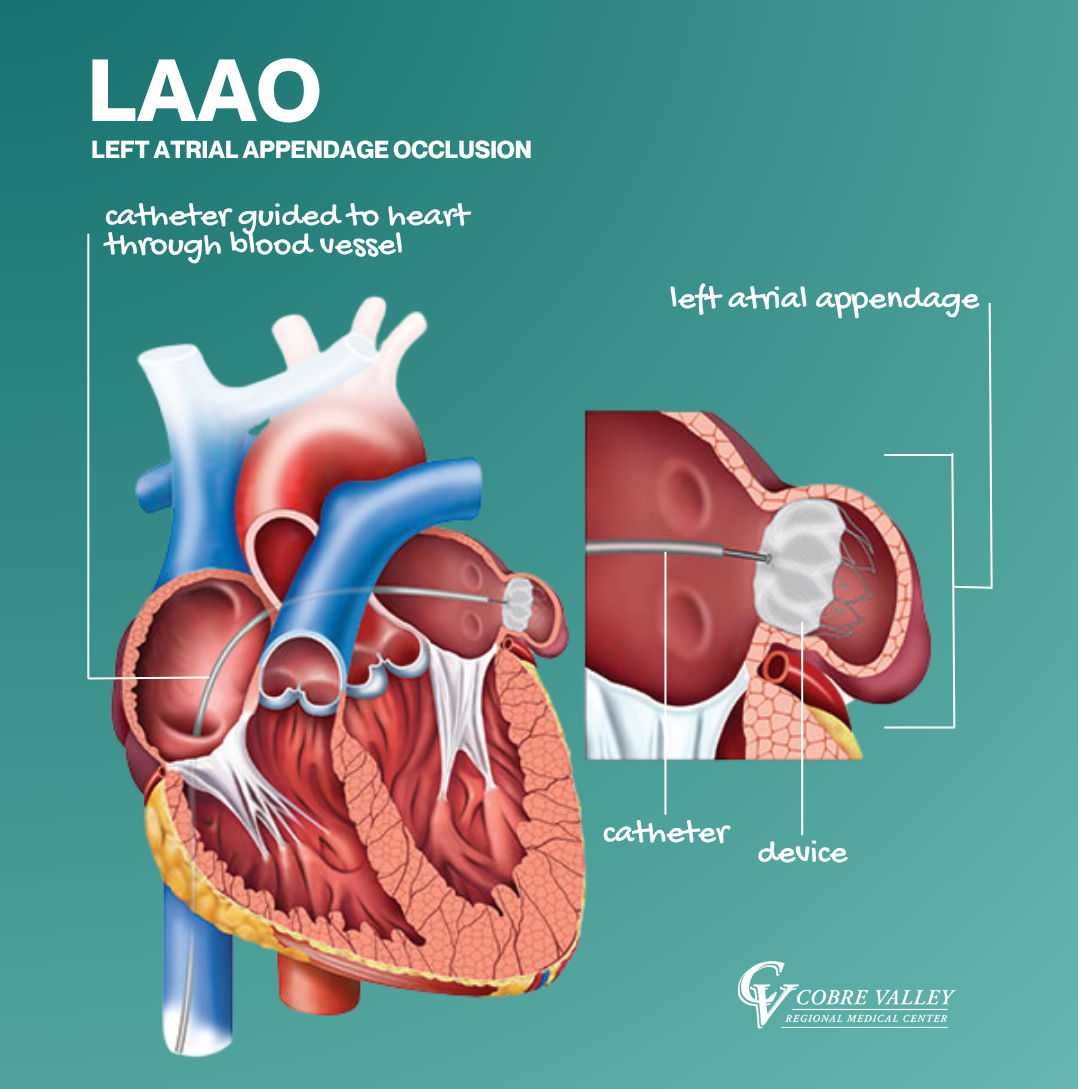A Breakthrough in Rural Heart Care
When it comes to specialized heart care, patients in rural communities often have to travel to major cities for advanced procedures. But that’s changing — thanks to innovation, perseverance, and a whole lot of teamwork. Our hospital recently became the first in Arizona to perform a highly specialized heart procedure — without the need for general anesthesia or a second physician. Here’s how we got there.
What Is Left Atrial Appendage Occlusion (LAAO)?
The heart’s left atrium has a small pouch called the left atrial appendage. In people with normal heart rhythms, blood flows in and out of this area without issue. But in patients with atrial fibrillation (AFib) — an irregular and often rapid heartbeat — the atrium doesn’t contract properly. Blood can pool in that little pouch, increasing the risk of blood clots and strokes.
For patients with AFib who are at high risk of stroke but can’t tolerate long-term blood thinners, the LAAO procedure offers a life-changing alternative. It uses a small device to seal off the appendage, preventing blood from pooling and reducing stroke risk.

The Innovation That Set Us Apart
Performing an LAAO procedure isn’t new — but the way we’re doing it is. Traditionally, this procedure requires:
- A transesophageal echocardiogram (TEE) — an ultrasound probe placed down the patient’s throat.
- A cardiac anesthesiologist to manage sedation and the TEE.
- General anesthesia — which can be risky, especially for older or medically fragile patients.
But here’s the game-changer:
Our interventional cardiologist, Dr. Bagga, trained extensively to use a tool called an ICE catheter (Intracardiac Echo). This allows the ultrasound imaging to happen through the groin, just like the catheter used for the procedure — no need for TEE, general anesthesia, or a second doctor.
After completing 30 certified cases using both ICE and TEE to prove the outcomes were the same, Dr. Bagga was cleared to move forward — and we became the first hospital in Arizona to use ICE-only for LAAO.
This not only reduces risk and cost, it also makes the procedure more accessible in smaller hospitals like ours, where cardiac anesthesiologists are hard to come by.
Who Qualifies for the Procedure?
Not every patient with AFib is a candidate for LAAO. It’s typically reserved for people who:
- Have chronic atrial fibrillation.
- Are at high risk of stroke (based on a scoring system).
- Cannot tolerate blood thinners due to:
- Frequent falls
- Bleeding disorders
- A history of gastrointestinal bleeding
The process starts with a referral — usually from a primary care doctor, a GI specialist, or a non-interventional cardiologist. Then, imaging like a TEE or CT scan is used to assess the size and shape of the appendage and determine if the procedure is the right fit.
What the Procedure Looks Like

The procedure itself is minimally invasive, taking about one to one and a half hours.A small catheter is inserted through the groin and guided up to the heart. A tiny device is then deployed into the left atrial appendage to “occlude,” or seal it.
Because we now use conscious sedation instead of general anesthesia, patients breathe on their own and recover more quickly. It’s a nurse-guided process that’s much gentler on older patients — the population most likely to need this procedure.
Recovery & Follow-Up
While some hospitals may send patients home the same day, insurance guidelines usually require a 1–2 night stay for observation. Patients receive an echocardiogram the following day to make sure the device is well-placed and there are no signs of bleeding.
After 45 days, a follow-up imaging test ensures the device is still in place and doing its job. If everything looks good, patients can often stop taking blood thinners altogether.
Most complications are rare and manageable — minor bleeding at the catheter site or a small amount of fluid around the heart. These are monitored closely and rarely require additional treatment.
Why It Matters
This program is a huge win for our rural community. Before this, patients often had to make three to four separate trips to Phoenix for imaging, the procedure itself, and follow-up. Now, they can stay close to home — and potentially get the procedure done sooner.
In fact, we already know of 30–40 local patients who need this procedure, and many have been on waiting lists in the Valley due to limited scheduling.
What’s Next?
We’ve completed our first day of procedures — three patients in one day — all successful. As demand grows, we hope to expand to two procedural days per month. This milestone is just the beginning for our Structural Heart Program, which is paving the way for more advanced cardiovascular care in our community.
And yes — we even handled an emergency heart attack (STEMI) in the middle of our first LAAO day. That’s the level of preparation, dedication, and skill our team brings to every patient.
Want to learn more? Talk to your primary care provider or cardiologist about whether the LAAO procedure might be right for you.
Because where you live shouldn’t determine the quality of care you receive.
Cardiovascular Associates of Arizona
5882 S. Hospital Drive
Globe, Arizona 85501
928-793-3747
Cardiac Catheterization Lab at Cobre Valley Regional Medical Center
928-402-1212

